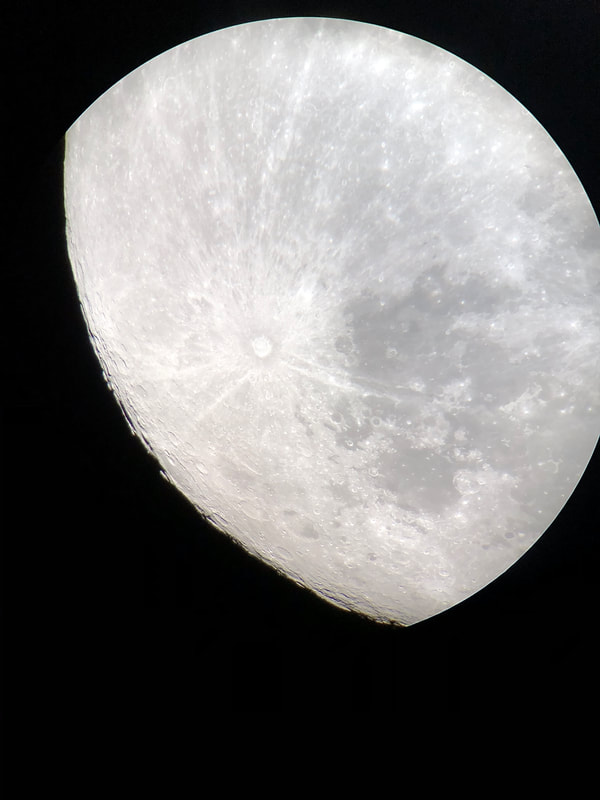|
The sky was clear the past two nights, as if to compensate for the arrival of COVID-19 in our city. Temperatures are rising, too, although they were plenty cool during that first night (March 7th). Since our baby still wakes up all the time - including every 1-2 hours at night - I once again walked up to our roof. Someday, I hope to be able to visit nearby parks again. On both nights, I stepped out with my Takahashi FC-100DC. The telescope is absolutely stable on my next AYO II mount - a significant difference over the AYO Traveller mount, especially in windy weather (and it's been a bit breezy here on the rooftop). Although ClearDarkSky forecast average seeing on both nights, I've learned to take that with a couple grains of salt, and indeed once again there seemed to be pockets of decent and poor seeing in the night sky. On the 7th, the nearly-full Moon appeared reasonably steady through my eyepiece; on the 8th, a high-altitude haze and turbulent air worsened the view considerably. Still, there's always something satisfying about seeing the apparently full Moon in the night sky, and then discovering a terminator with a telescope. I can only step out at around 8:30 most nights - after my daughter goes to bed - and at that point Venus, which is now near opposition, is sinking quickly towards the horizon. Not only does it then shine through a lot of atmosphere, but it's also just above a bank of currents boiling up from some pipes on our rooftop. And when I turn my telescope to have a look, it's usually right after I set up, when the tube still hasn't fully cooled down. Venus is, in other words, usually a shimmering mess of false color. Yet on the eighth, for maybe five glorious minutes, I did get a nice view early in the evening, at around 82x with my Nagler Type 6, 9mm eyepiece (it's a favorite). Any more magnification, and the view softened in a hurry. At 82x, however, I thought I might just be able to make out some darker details in the disk; in fact I was quite sure of it, but of course unlikely visual phenomena that are just at the edge of perception should always be taken with a healthy dose of skepticism. Minutes later, the view broke down and Venus was out for the night. On both nights, with Orion very high in the sky, I easily split Rigel A and B. Turning to the Orion Nebula, I think I was able to make out five - perhaps even six! - stars in the Trapezium on the 7th. At 123x, the whole view seemed full of delicate nebulosity (faint, however, because I'm surrounded by lights on our rooftop and my eyes don't fully dark adapt). On the 7th, a small crowd came out to our rooftop and one young man wandered over. He asked me what I was looking at; I mentioned the Orion Nebula. "What's a nebula?" he asked. Vinny - that was his name - now you know! On both nights, I did a little equipment testing. First, I've been tempted by the new Takahashi FC-100DZ. Its color correction is a bit better than that of my 100DC, especially at red wavelengths. With Mars reaching opposition later this year, it might be an upgrade worth making. On the other hand, the slight improvement in color correction comes at the cost of a longer focal ratio (F8 VS F7.4) and a substantially heavier (33% more!) tube. That may mean that I can't mount the DZ on my lightest-weight tripod and mount. And I wonder whether the DZ would complement my Mewlon as nicely as my DC can - at least in theory, since I rarely have a chance to use the Mewlon. The false color around Venus and even the Moon on the 8th (in poor seeing) did make me think, but for now I definitely lean towards keeping the DC.
I also tested a new pair of binoculars on the eighth. For a while, I've been looking for binoculars that aren't too expensive - I don't use binoculars enough to justify a high price - but also are more than toys. The big Celestron 15x70 binoculars that I've mentioned earlier in this space quickly fell out of collimation and are now completely useless. I bought a small (8x42) pair of well-reviewed Oberwerk binoculars last year, but they were surprisingly heavy, and they too lost collimation in a hurry. I returned them and replaced them with Nikon 10x50 Action Extreme binoculars. Right off the bat, the feel and size of the binoculars felt right. They were actually easier to hold steady than the smaller Oberwerk binoculars. Turning to the Moon, the view impressed: a bit of false color no doubt magnified by that high-altitude haze, but wonderfully sharp nonetheless. I think this pair is a keeper, and at $150 I don't have to feel that it represents a blown investment if I don't use it much.
0 Comments
Leave a Reply. |
Archives
March 2024
Categories
All
|









 RSS Feed
RSS Feed